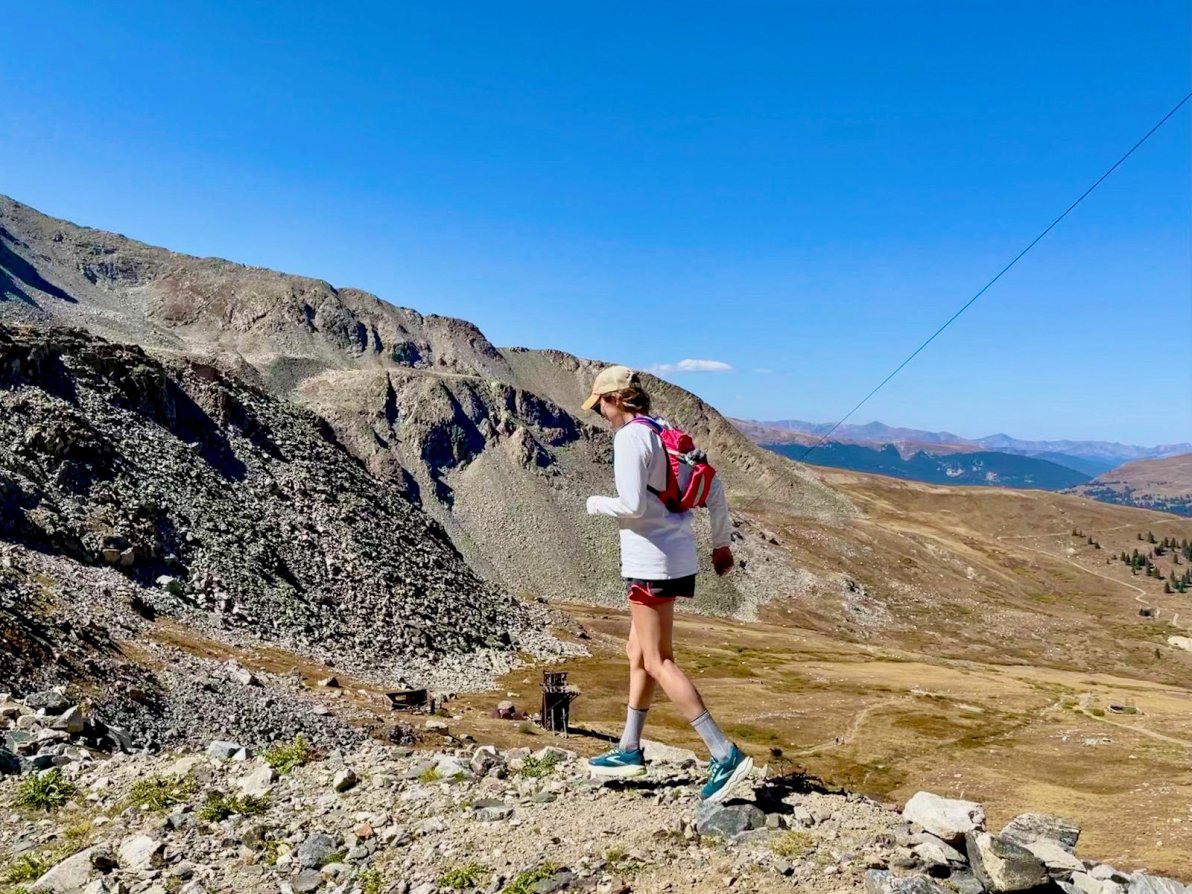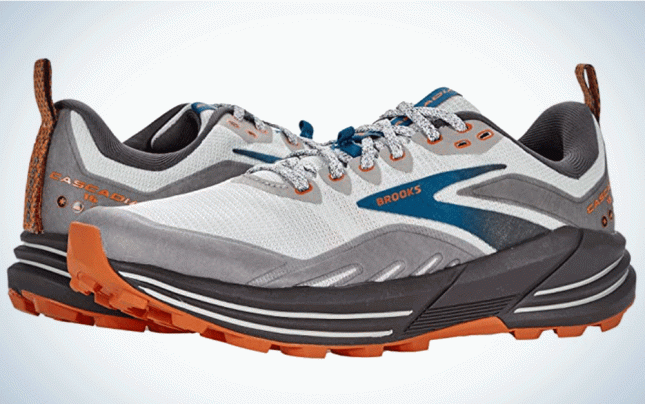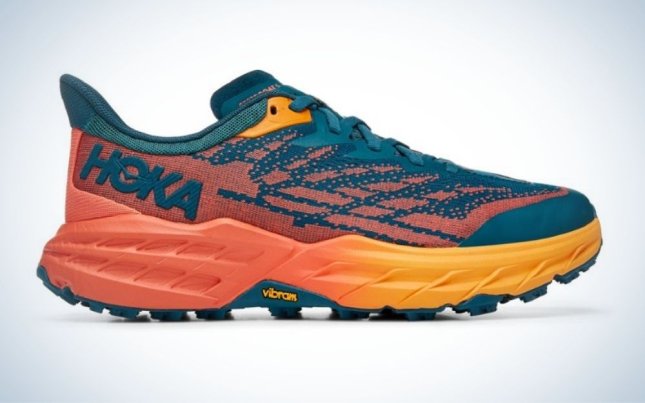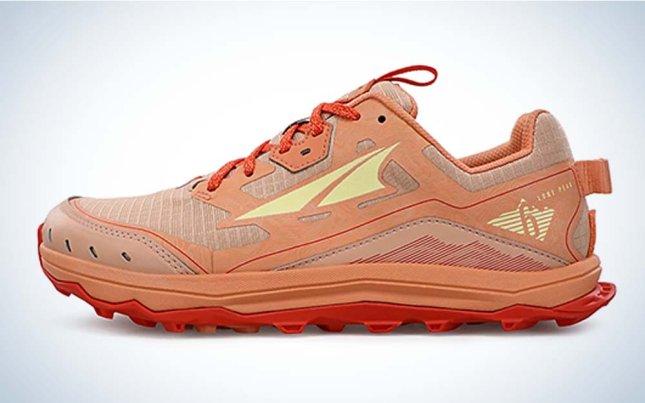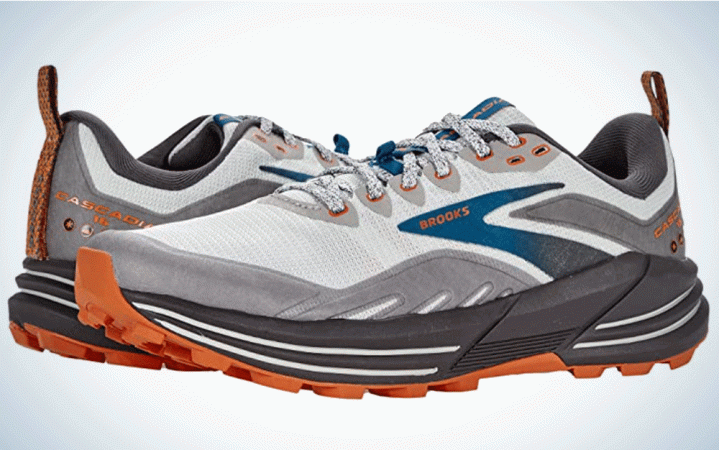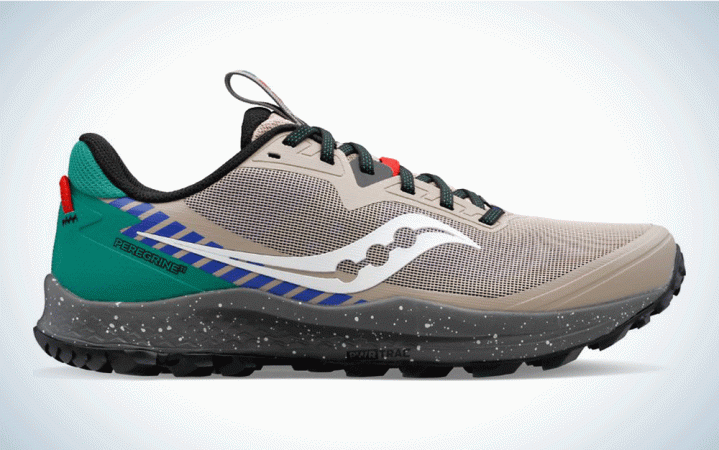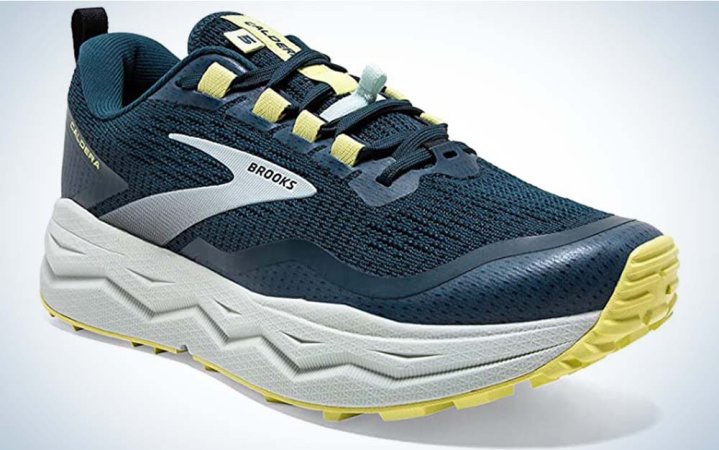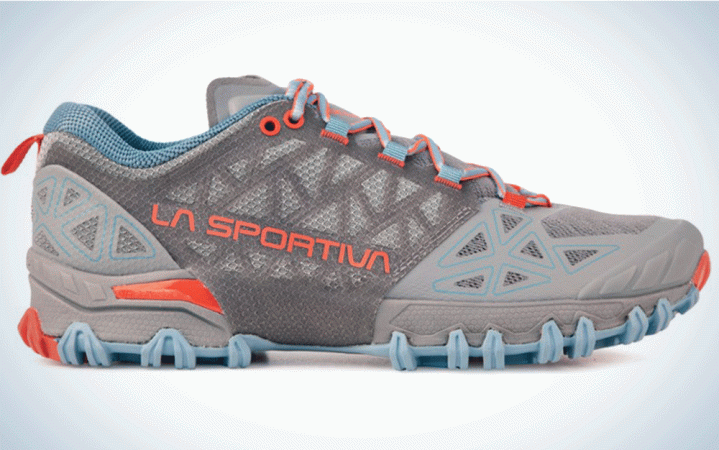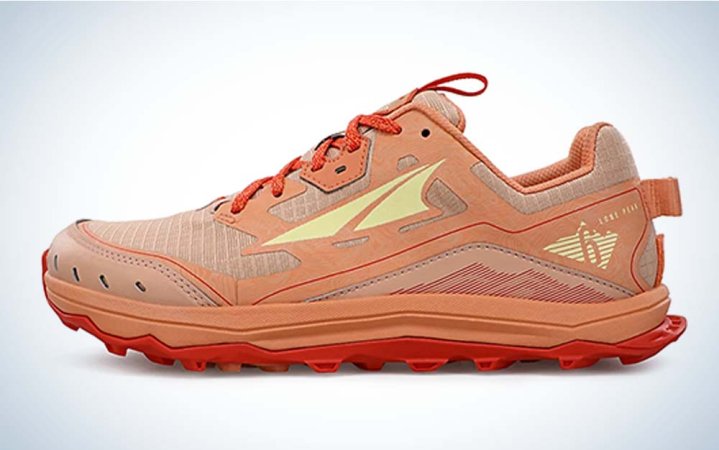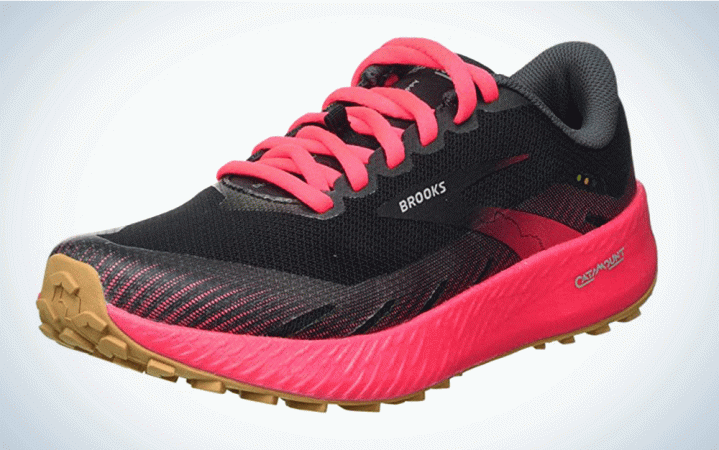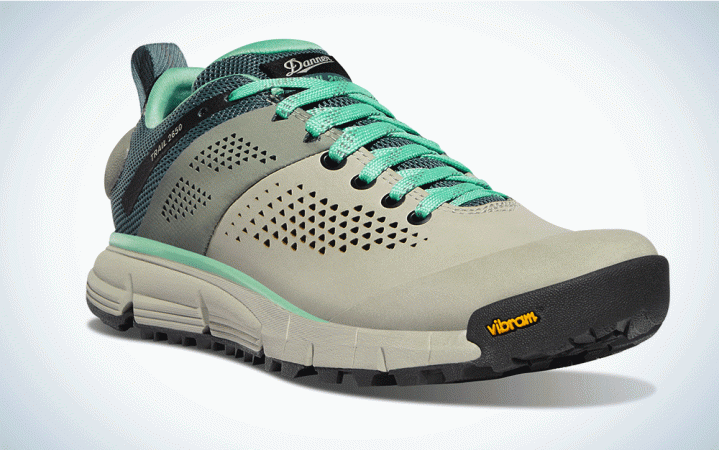We may earn revenue from the products available on this page and participate in affiliate programs. Learn More ›
Over the last few months I’ve been lucky enough to get out and test the best of the best trail running shoes currently on the market and give you a roundup of my top picks. I ran and hiked over 400 miles of trail in all weather conditions across my home state of Colorado since September to bring you my favorite shoes out there.
Trail running is one of the best ways to get outside with a pretty low barrier to entry. It all just starts with a pair of shoes and knowing where you want to go. Novices to experienced trail runners are bound to find a recommendation on this list that is right for them:
- Best Overall:Brooks Cascadia 16
- Honorable Mention: Saucony Peregrine 11
- Best for Long Distance Runners: Brooks Caldera 5
- Best Hybrid: Hoka Speedgoat 5
- Best Traction: La Sportiva Bushido II
- Best Zero-Drop: Altra Lone Peak 6
- Fastest Trail Running Shoes: Brooks Catamount
- Best Lightweight Hikers: Danner Trail 2650
Because trail running looks completely different from one person to another—from a 100-mile ultramarathon to a lap around your neighborhood park—I evaluated each of these shoes based on their intended use, comfort, functionality, and the scenarios where they stand out from the crowd (see the end of this article for more in-depth methodology).
So, whether you’re a hunter looking to get in shape for a trip out West this fall, a runner who hasn’t had success with your most recent pair of shoes, or looking to try a new sport, I hope at least one of these pairs of shoes will get you or a loved one adventuring in 2022. Remember, if you’re just starting out, it’s not about how far or fast you go, it’s about taking time out of your day to get outside and push yourself, even just a little.
Happy running.
Best Trail Running Shoes: Reviews & Recommendations
Best Trail Running Shoes Overall: Brooks Cascadia 16
Key Features
- Soft cushion
- Weight: Men’s: 10.5 ounces, Women’s: 9.5 ounces
- 8mm heel-toe drop
- TrailTack rubber outsole for wet/dry traction
- Gore-Tex option
- Available in medium and wide
Pros
- Comfortable and lightweight
- Versatile
- Gore-Tex option
Cons
- Looser and larger than typical Brooks shoe
- If you’re a traditionalist, there have been some changes to previous Cascadia models (both cons could actually be a pro for you)
The Cascadia has been around since the early 2000s for a reason. It’s the first shoe I’d recommend as the best trail running shoe for beginners, or for someone who needs to get a pair right now without much time to research. I’ve hiked, trail run, and even road run and sprinted in these shoes, and have been impressed with how all-around solid they are. This shoe is 5% softer and 20% lighter than the Cascadia 15s, with drainage holes, grooves in the midsole, Ballistic Rock Shield that supports you navigating tough terrain, and a more flexible foundation (this isn’t the only soft cushion shoe on this list, but it does feel faster). While some of the other shoes on this list may check your more specific boxes—like a lower drop or more rugged traction—the Cascadia can truly do it all.
It’s important to note that even if you’re a regular Brooks runner, you should still try the Cascadia 16s on before buying. As I mentioned above, they run a little larger than other Brooks shoes, and definitely have a wider toe box than Brooks is typically known for. If you generally find Brooks a little too narrow, then this is a fantastic variation.
Honorable Mention: Saucony Peregrine 11
The Saucony Peregrine 11s are a fantastic all-around trail running shoe, especially for beginners figuring out what works best for them and experienced runners who like a narrow, firm sole. The Peregrine 11 and Cascadia 16 have a lot of things in common, like weight, solid traction, durability, and a rock plate, but two notable differences are the Peregrine’s lower 4mm drop (compared to 6mm) and the comfortability of the two shoes’ cushions. If you have a narrow foot fit for Saucony and prefer a very firm sole, this is a great all-around shoe I’d recommend ten times over, but it’s not my universal recommendation—the Cascadia 16 is softer and much more forgiving.
What I love about this shoe is how well it adapts to various conditions and how durable and stable it feels on smooth to moderate trails. That being said, I personally develop soreness in my heel and ball of my foot after running in them around mile five, give or take, because of their firm sole and snug fit (this is a common complaint). If you’re a loyal Saucony runner or what you’re reading sounds like you, then the Peregrine 11s are your best overall shoe.
Best Trail Running Shoes for Long Distance Runners: Brooks Caldera 5
Key Features
- Thick, firm cushion
- Weight: Men’s: 10.6 ounces, Women’s: 9.4 ounces
- 4mm heel-toe drop
- Designed for ultra trail runners
- BioMoGo DNA midsole for stability on challenging terrain
- TrailTack rubber for traction
Pros
- Stability on rugged terrain
- Performs in winter conditions
- Comfortable on long runs
- Responsive (despite high cushion)
Cons
- Doesn’t come in wide
- Feels clunky if speed is the goal

These shoes are the fat bikes of trail runners. They’re firm, comfortable, and here for the long haul. While they’re not the fastest shoe I’ve ever run in, going downhill, I felt extremely safe and secure rolling over roots and rocks. The Caldera 5s certainly give me the confidence to push harder. Even though they have one of the thickest soles I’ve seen from trail runners, they only have a 4mm heel-toe drop, meaning I don’t feel myself sitting back on my heels on long runs.
Brooks advertises the Caldera 5 as an ultra trail shoe, and it is definitely my top recommendation for anyone crushing long miles or training for an ultramarathon. Typical to Brooks, their reactive (in this case, maximum) cushion keeps your feet protected for long runs. These shoes may seem bigger and boxier in comparison to other Brooks models, but for something designed to keep you running for a long time at a slower pace, they’re a blessing once you start to get into double digit miles on less-forgiving trails.
Best Hybrid: Hoka Speedgoat 5
Key Features
- High, balanced cushion
- Weight: Men’s: 10.3 ounces, Women’s: 8.5 ounces
- 4mm heel-toe drop
- Vibram Megagrip outsole
- Gore-Tex option
- Available in regular and wide
Pros
- Great traction and improved stability from previous models
- Comfortable
- Excellent in wet, slippery conditions
Cons
- Feel heavier than they actually are
- Some runners/hikers prefer less cushion
Living in Colorado, the Hoka Speedgoat 5s are my go-to shoes for rough terrain; they’re the most comfortable and have the best traction. I’ve climbed many mountains—ranging from solid trail to steep skree fields—backpacked, and ran in the Speedgoats, and have always felt secure and supported. Hoka is known for its thick cushion, which is incredibly comfortable, but at the end of the day, it’s up to preference.

It’s important to note the Speedgoat 5s come with all the improvements I hoped for from the previous Speedgoat 4. Last summer, I almost exclusively hiked in my Speegoat 4s and Mids, but the 5’s makeover makes this shoe even more enticing for times I’d opt for a less-bulky shoe. The Speedgoat 5 has been almost entirely reconstructed, with a flexible yet structured, double-layer, breathable mesh upper (and it’s recycled). This makes an already-stable shoe even more reliable, catering to a wide variety of runners and hikers. And not only is it lighter, the shoe just feels less bulky than other Hokas. Hoka is known for their high cushion, but this lower cushion actually feels more reactive and protective. It’s hard to provide ample cushion and maintain a natural feel when you foot strikes the ground, but this iteration of the Speedgoat manages it well.
That being said, while I am going to opt for the Catamounts or Lone Peaks for a faster, more tame trail run, I’ll go a little out of character and pick this bulkier (albeit, recently less bulky) shoe to be confident on technical terrain. If you’re already an avid fan of the popular Hoka Clifton road shoes, then it’s a no-brainer that these are the trail shoes for you.
Best Traction: La Sportiva Bushido II
Key Features
- Low, firm cushion
- Weight: 10.5 ounces
- 6mm heel-toe drop
- Stiff midsole and forefoot rock plate
- Available in European half sizes for a more exact fit (Men’s, Women’s)
Pros
- Sensitive yet durable
- Great traction for rocks
- Versatile across trail running and hiking
Cons
- Fit primarily for narrow feet—doesn’t come in wide
After running and hiking in these shoes, I feel like they offer the best of both worlds in terms of speed and support. And where they really stand out is in their sensitivity. My feet feel super protected while running over rocks and loose gravel, but I’m not too far away from the ground (the shoe’s V-grooves really excel running downhill). Additionally, the Bushido IIs have a forefoot rock plate that protect your feet on rough terrain. A danger with some firm trail running shoes is that rubbing from the firm sole and heel can cause blisters, but that isn’t the case here. I even got my feet wet and kept running without any hot spots a few miles later (albeit the shoe isn’t super water resistant). I can’t wait to climb technical peaks in them this summer and feel solid running the downhill.
I don’t think you can go wrong with the Bushidos, but I love a firm, lightweight shoe—and I have very narrow feet. But if that doesn’t sound like you and you’re looking for a high traction running/hiking shoe, check out the Speedgoats for a little more room and cushion.
Best Zero-Drop Trail Running Shoes: Altra Lone Peak 6
Key Features
- Thin, moderate cushion
- Weight: Men’s: 10.6 ounces, Women’s: 8.7 ounces
- Zero heel-toe drop
- Responsive AltraEGO midsole and MaxTrax outsole
- Super-effective drainage holes
- Available in regular and wide
- Updated laces and outsole from previous model
Pros
- Wide toe box
- Zero drop mimics natural running
- Fast and reactive shoe
- Versatile
Cons
- If you don’t really ease into a zero-drop shoe, you risk injury (you have to focus on achilles and calf strength)
- Adjusting to zero drop is a huge change and can put a lot of stress on feet and lower legs without proper conditioning
- Not my first pick for particularly rough terrain

The Altra Lone Peak 6 is one of my favorite trail running shoes and hiking shoes that performs great over long distances, as well as on shorter, faster runs. Its combination of a tight, supportive heel and a wide toe box make them everything I love about zero-drop running shoes, mimicking a “barefoot,” natural feel. And while it does everything right, in my opinion, for a minimal shoe, its midsole is equipped with comfortable cushioning and a solid rock plate.

On the multiple trail runs I tested these shoes, I felt strong and confident throughout. If I had maybe paid a little more attention to the forecast when packing for a trip to the Maroon Bells Wilderness in Aspen, Colorado (pictured above), I may have grabbed a different pair of shoes, but even amidst sleet and a steep pass covered with wet leaves, I felt in control even in the moments I slowed down out of caution. Read the OL gear team’s full review: Altra Lone Peak 6 Review: We Put the Best Hiking Shoe to the Test.
All of this being said, if you are not a zero-drop enthusiast, do your research and ease in slowly before making the Lone Peak 6s your go-to trail running shoe. If you find you’re still looking for some heel support but like the Lone Peak’s firm cushion, I’d direct you to the Brooks Catamounts, which perform similarly, with the major difference being a 6mm heel-toe drop.
Fastest Trail Running Shoes: Brooks Catamount
Key Features
- Ultralight cushion
- Weight: Men’s: 9.3 ounces, Women’s: 8.8 ounces
- 6mm heel-toe drop
- Sticky TrailTack rubber for grip
- Ballistic Rock Shield to navigate tough terrain
Pros
- Speed oriented: solid, reactive sole
- Works best on hard-packed trail
Cons
- Subpar on steep and muddy downhill
- Don’t come in wide (Brooks shoes already run small)
Compared to the other two Brooks trail runners on this list, the Catamount has a firmer sole and mimics the feeling of a road shoe. It’s exceptionally comfortable on flat, solid terrain, and is one of the most responsive and quick trail runners I’ve ever run in. While it has a 6mm drop, I don’t particularly find myself sitting back on my heels because of how light and flexible its cushioning is.
The toe box is also wide enough to feel breathable and comfortable, without the potential for feeling too loose or non supportive (I have a fairly narrow foot). That being said, if you’re looking to run loose and steep or wet trails, test out the Catamounts before you commit. They’re my top choice for solid ground, but I find myself wanting a little more when it comes to the tricky stuff. These are definitely my top pick for a trail race, but it’s important to note that some runners have experienced wear on the Catamounts approaching 100 miles, but after about 40 so far on mine, I have not found any issues.
I find they run similar to the Altra Lone Peaks in their responsiveness, quickness, and overall fun. But if you’re looking for even more sensitivity, consider the Altra Lone Peak 6s. If you need more support and cushion without sacrificing responsiveness, I’ll direct you to the Brooks Calderas.
Best Lightweight Hiking Shoes: Danner Trail 2650
Key Features
- Weight: Men’s: 24 ounces, Women’s: 18 ounces
- 8mm heel-toe drop
- Firm Vibram 460 outsole
- Available in men’s and women’s regular and men’s wide
- 6 different models: Trail 2650, Trail 2650 Gore-Tex, Trail 2650 Mid, Trail 2650 Mid Gore-Tex, Trail 2650 Campo, and Trail 2650 Campo GTX
Pros
- Lightweight—unlike many traditional hiking boots—without sacrificing support
- Good for hiking long distances and they do well with steep incline
- 6 different models for every application
Cons
- Women’s shoes don’t come in wide
- Slightly restrictive toe box
- Laces are too short

While the 2650s aren’t trail runners, they earned a spot on this list because while some people—myself included—enjoy hiking in trail running shoes, sometimes there’s just not enough support when carrying a heavier pack for longer distances. They’re still light enough to feel mobile and comfortable, but definitely keep you more snug and secure than a running shoe on backpacking trips.
Read Next: Best Men’s Hiking Shoes, Best Women’s Hiking Shoes
What makes these shoes at the top of my list for long hikes is their foot protection. There’s significant protection on the heel and toe, and its leather body is durable, even in the non-waterproof model. Even further, Vibram consistently makes strong, long-lasting soles that I always trust on long trips.
As one of the lightest hiking shoes I’ve ever worn, they’re still sturdy with great traction, but if you’re someone needing an extra level of support—especially around your ankles—you may want to stick to a more traditional hiking boot.
Methodology
I evaluated this list of trail shoes based on their advertised specialty (long distance, speed, etc.). I ran a minimum of 20 miles—most were closer to 50—on each pair of shoes. The only exception is the Danner Trail 2650s, which I only tested hiking at various speeds on different terrain. Here were my initial three tests:
- 6-mile hike
- 6-mile run on the same trail
- 3 miles on more compact and flat dirt trail to test speed and my preferred pace in each shoe
Throughout those 15 miles, I judged the following qualitative and quantitative factors:
- Cushion, heel drop
- Ankle stability
- Perceived weight
- Versatility
- Durability, traction
- Kind of runner it’ll best suit
Based on this initial evaluation, I set out to see how each shoe specialized. At this point, I had a sense of what would prompt me to choose each shoe, depending on the type of run/terrain:
- Speed category
- Long distance category
- Rugged category
For the final testing stage, I integrated them into the activities I regularly do, making sure my winners for each category were my first pick for each specific run or hike. It’s important to note all the shoes I tested for this roundup were testers given to me by brands, but if I wouldn’t purchase a pair of trail runners at full price—which I will—they wouldn’t be on this list.
How Do You Choose the Right Pair of Trail Running Shoes?
Finding the best running shoes for you is incredibly subjective, so figuring out what style of shoe you prefer and what kinds of runs you plan to do are going to guide you to finding your best fit. Here are a few things to consider as you browse this list for your next—or first—shoe purchase:
- Width (You want some room, but not too much that your shoe rubs)
- Toe box (The wider the toe box, the more room your toes have to swell. It can also provide a stable, more-natural feel)
- Weight
- Stack height (Are you looking for more cushion, or something closer to the ground? Remember, firmness and amount of cushion aren’t always the same)
- Drop (a high heel-to drop is best for runners who strike with their heels first, while a lower drop is for forefoot or midfoot strikers who want a more “barefoot” feel)
- Do you need a waterproof shoe or drain holes?
- How much traction are you looking for? Is a rock plate important to you?
FAQs
There’s no straightforward answer, but many companies and running experts suggest around 300-500 miles (5-6 months if you run 25-30 miles a week), but it also depends on the level of cushioning and type of terrain you’re running—for example, the Brooks Calderas will likely last longer than the Altra Lone Peak 6s. Also, try not to wear your running shoes for other activities. I have a separate pair of Hoka Clifton 8s strictly reserved for around-town and gym shoes, so I don’t put any extra miles on my Brooks road shoes. But there’s no cut-and-dry answer, so it ultimately comes down to you being responsible and checking in with your body and miles. It’s also a good idea to rotate more than one pair of shoes so your body can adapt to different shoes and give each pair’s midsoles time to bounce back.
As a beginner trail runner, it’s important to start slow, build up your strength and conditioning, and not overdo it. That’s why I recommend the Brooks Cascadia as a great all-around shoe to help you get started. If you’re an experienced runner getting into trail running, you may already know what kind of shoes you’re looking for based on your mileage and your gait, but if you don’t know where to begin, the Cascadia will give you a great foundation. After, if you’re looking for something firmer, faster, or lighter, then this list will help you expand your horizons.
You’ll frequently hear to size up a half size, which isn’t wrong, but always check the specific brand’s sizing and customer reviews before you buy a new pair of trail running shoes. Even if you plan on ordering your shoes online, it’s a great idea to visit a local running store to try on the same or similar shoes. While I wear a women’s 7.5 in everyday shoes, I fluctuate a half size in either direction, depending on the brand of running shoe. I’ve definitely lost a toenail or two or 10—but who’s counting?—from running in shoes I blindly ordered and went on a long run the second they arrived.
Final Thoughts on the Best Trail Running Shoes
As I’ve said throughout this roundup, finding the best trail runner for you is pretty subjective. So, know your body, how far you want to run, and don’t make any drastic adjustments too quickly (like shelving your Hokas for a 10-mile run in Altras straight out of the box). If you’re comfortable and feel supported, no matter how far or fast you’re going, then you’ve accomplished my mission. Enjoy your run or hike, and get outside.
